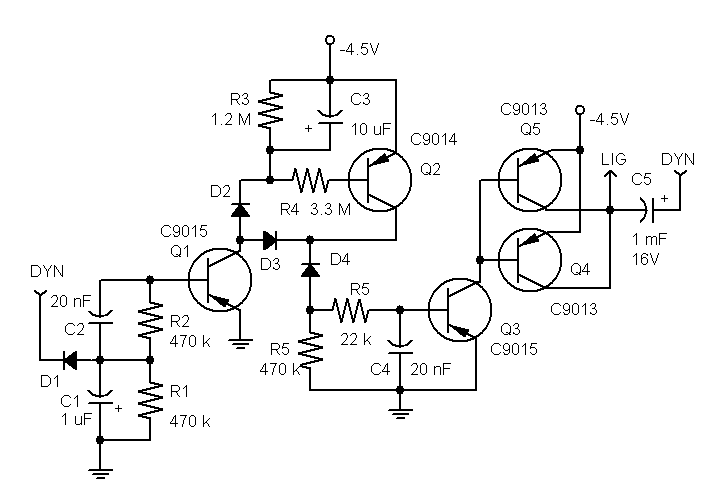Schematic for a "Constant Light Control"
|
This is a schematic of the circuitry of
a no-name
stand-light, marked Constant Light Control Model CL-58,
marketed in a German supermarket chain. Note: I produced this schematic by examining the circuit, and cannot quite guarantee its accuracy. In particular, I had no chance yet to put the circuit on a breadboard and test its operation there. |

|
|
The dynamo connects between the ground and DYN. The lights connect
between the ground and LIG. The batteries connect between the
ground and -4.5 V.
The four diodes are all low signal. Features of the transistors may be examined at that site and elsewhere. |
Operation
|
An interesting feature in this stand-light is the use
of the 1000 uF capacitor C5 connecting the dynamo to the
lights. The capacitor will be cutting off the power to
the lights at low speeds. For a bottle dynamo, these
would be such low speeds that the effect should be irrelevant.
However, the effect may become unacceptable for a hub dynamo
that operates at lower frequencies than bottle.
Anyway, the circuit operates as follows. An operating dynamo charges the capacitor C1 through D1. This turns Q1 on. When Q1 is on, it charges the capacitor C3 which puts Q2 on. As long as Q1 is on, the current through Q2 flows through D3 and Q1. When the dynamo stops, C1 quickly discharges putting Q1 off. With C3 remaining charged, Q2 continues to be on, but now the current flows no more through Q1 that is off, but through R5. This puts Q3 on, which switches on Q4 and Q5 that connect the battery to the lights. After C3 discharges, Q2 goes off and so do Q3-Q5. Q4 and Q5 are connected in parallel because the use of one such transitor, with a max current ICE of 0.5 A, would put that transistor too close to the boundary of its safe operation. |
Comments
|
Important consideration for a commercial products is the price
of components, as it inflates the retail price, affecting the
popularity of a product, and it erodes the profit from an
individual unit. From the components, surprisingly the
transistors are dirt cheap (few cents in a large quantity) and
so are small-signal diodes as
well as resistors. Electrolytic capacitors get expensive when
their capacity gets up into the thousands of uF; also expensive are
better relays
and operational amplifiers, and MOSFETs can
easily run into the vicinity of $2 apiece. A design clinging
to transistors is then more likely to become commercially
successful than one utilizing MOSFETs. When the work is well
organized, the labor seems to come in relatively cheaply.
On the other hand, when a tinkerer spends weeks to months worth of evenings on prototyping, the price differential between a transistor and a MOSFET can appear irrelevant. At the same time use of MOSFETs allows for better more efficient circuits; the use of operational amplifiers allows for flexibility without mounting complexity and with little power cost. As of 2001, all stand-alone stand-lights other than the one above appear to be out of production. During my few months in Germany, I have not, in fact seen a single such stand-light in use. On the other hand, I have observed Lumotecs with their stand-lights in operation. One may ponder why the stand-alone stand-lights have not had more success. One issue may be the effort required on the part of the user to decide about the need and to get one installed. In Germany, the city streets are well lit, the bicycles are common in the evenings and maybe a fifth of those bicycles moves without any lights whatsoever. Maybe there is not enough pressure to bother with a stand-light. On the other hand, if the stand-light comes with a headlight that one gets anyway, then why not. One more issue may be the maintenance. The stand-alone stand-lights have been designed to work with the common dynamos and the most common are the bottom line dynamos. Such dynamos can get you home but their use during the day to recharge batteries is, in practice, out of question. The use of regular batteries keeps, otherwise, the cost and complexity down, but requires replacing the batteries. Many of those who ever get such a stand-light may, possibly, never get beyond one or two battery sets. |